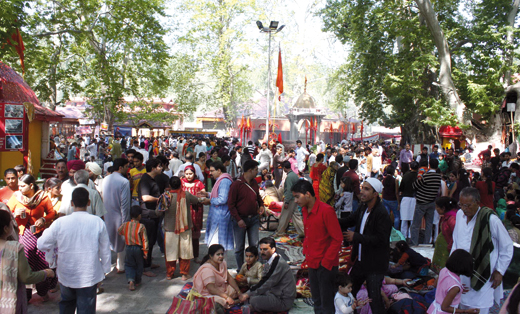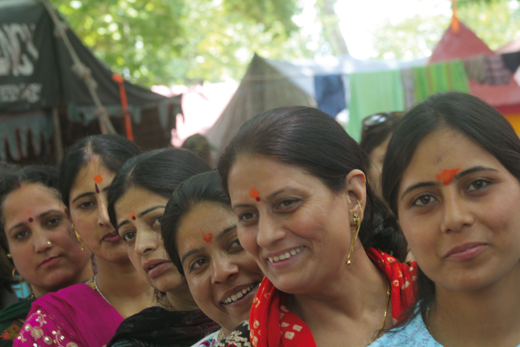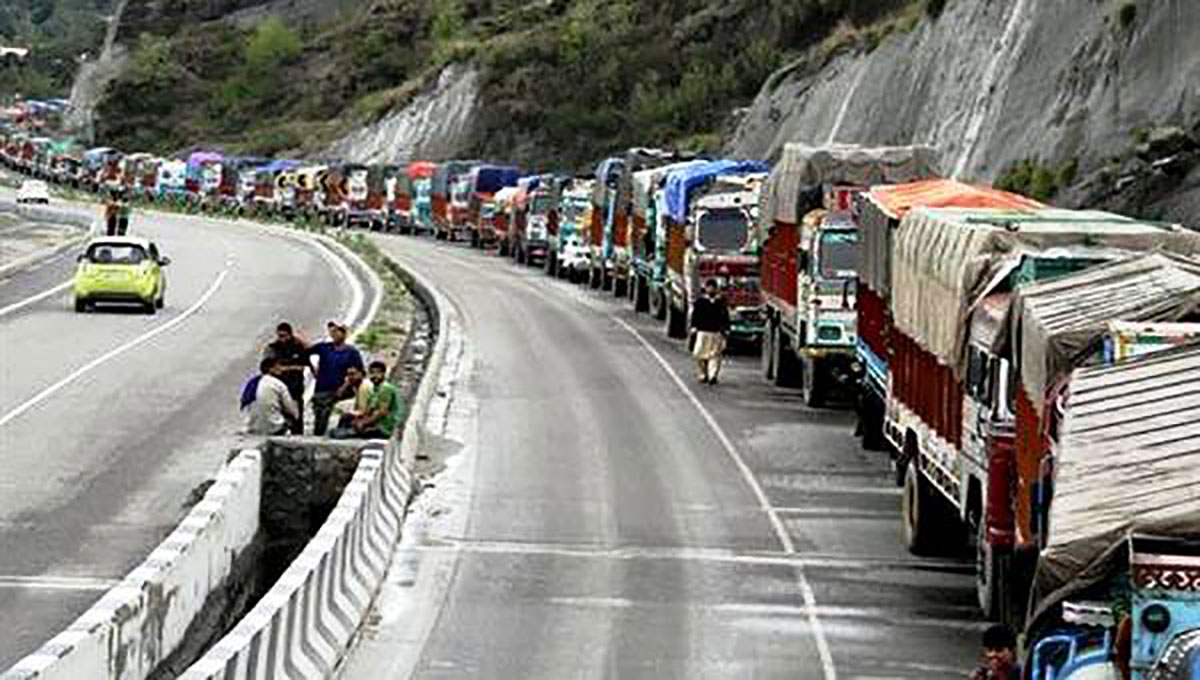As a Parliamentary Committee strongly suggests J&K government must consider declaring migrant Kashmiri Pandits a minority given the “pitiable condition” they live in, R S Gull profiles the consistent efforts that successive governments have put in at exorbitant costs to make them comfortable and encourage their dignified return
When PDP’s Syed Bashir was caught on camera slapping a Marshall, tasked to send him away from the well during the ongoing session of the state legislative assembly, he was protesting over the facilities for Kashmiri Pandits (KPs). Bashir was seeking uninterrupted availability of food grains to the migrants in their camps. As the authorities skipped responding to an angry old man, Speaker Mubarak Gul ordered the lawmaker be taken out. It was in this process that he slapped the assembly official, an issue that led him to apologize unconditionally the next day.
But if his protest is taken at face value, then J&K government – that has created the state relief organization (SRO), only to manage the affairs of the migrants is not doing anything for the community that left Kashmir at the start of militancy. But during the session, the government places on record a number of documents and details that gave an insight into the status of the KP migrants. Here is the brief crux of various facets of the relief, rehabilitation and the present conditions of the migrants:
Currently, there are 40857 migrant families living in Jammu. Besides, there are 21333 families living mostly in Delhi (see Table 4: Migrants living across India), and other parts of India. Those who live in Jammu, 18681 fall under relief category. Under the system in vogue, families having no member of serving state or the central government are entitled to cash relief. It started within days after the migrants were registered in Jammu in 1990 with Rs 500 per head per month to a maximum of Rs 3000. It was gradually increased and right now the scale is Rs 6600 per family per month.
Right now, there are 18681 families entitled to relief and 22176 not registered for cash assistance. Families having one member of the family serving the government are not eligible for any cash assistance because their salary is being considered as ‘leave salary’. A new term that can be attributed to the conflict, it means getting salary without putting in any effort towards the employer. Since most of the migrants are putting in far away from their actual places of posting, they cannot deliver the services they were supposed to. So they get salary without any work.
|
Table 1: District Wise Distribution Of Kashmiri Migrants In Jammu |
|||
|
District |
Relief |
Non Relief |
Total |
|
Islamabad |
4436 |
4690 |
9126 |
|
Budgam |
1728 |
2174 |
3902 |
|
Baramulla |
2200 |
1857 |
4057 |
|
Bandipora |
204 |
191 |
395 |
|
Ganderbal |
319 |
425 |
744 |
|
Kulgam |
1093 |
1133 |
226 |
|
Kupwara |
1367 |
1618 |
2985 |
|
Pulwama |
1209 |
1564 |
2773 |
|
Shopian |
556 |
651 |
1207 |
|
Srinagar |
5569 |
7873 |
13442 |
|
Total |
18681 |
22176 |
38857 |
|
Source: Revenue & Rehabilitation Ministry, J&K Government Jammu |
|||
However, off late, some of them have been engaged with service delivery in camp offices of the parent organizations and also managing the affairs of the state run utilities that were set up for them only. In his budget speech Abdul Rahim Rather, state finance minister said he has kept a provision of Rs 183.24 crores for the leave salary for the fiscal 2014-15.
Interestingly, Rather mentioned of the money he had set aside last fiscal for managing insurance cover of the migrants. “The medical insurance scheme for the migrant families proposed by me quite some time back hasn’t taken off so far,” Rather said.” However, my offer for extending financial assistance for this purpose shall continue in future as well.”
The government also made clear that a fairly large number of migrants does not mean fresh migration is taking place. Asserting that 869 Pandit families are still staying put in Kashmir – some of them in ‘special security zones’, the state Revenue Ministry said only 29074 families were registered with the SRO at Jammu in 1997. The bifurcation of the families has surged the number of families to 40857, it asserted. (See Table 3: Changing Numbers in Kashmiri Migrants)
|
Table 2: Expenditure On Migrants In Jammu |
||||
|
Year |
Cash Assisstnace |
Food Grains |
Infra |
Civic Action |
|
1989-90 |
115 |
30 |
57.44 |
8.1 |
|
1990-91 |
3665 |
860 |
165.9 |
6 |
|
1991-92 |
2757.7 |
668.97 |
143.2 |
51.68 |
|
1992-93 |
608.41 |
488.97 |
256.72 |
24.53 |
|
1993-94 |
1362.04 |
488.78 |
618.64 |
18.96 |
|
1994-95 |
2119.52 |
450 |
559.88 |
35.8 |
|
1995-96 |
2152.82 |
450 |
125.83 |
32.07 |
|
1996-97 |
2513.52 |
530.7 |
48.58 |
49.95 |
|
1997-98 |
2841.79 |
542.07 |
72.68 |
54.96 |
|
1998-99 |
2842.2 |
600 |
63.81 |
70 |
|
1999-2000 |
3812.1 |
499.22 |
60.88 |
55 |
|
2000-01 |
3903.9 |
1458.93 |
56 |
54.99 |
|
2001-02 |
3986.76 |
886.22 |
42.21 |
140 |
|
2002-03 |
4015.09 |
787.78 |
69.87 |
149.79 |
|
2003-04 |
4669.31 |
788.19 |
118.92 |
64.95 |
|
2004-05 |
5051.39 |
782.2 |
162.39 |
64.98 |
|
2005-06 |
4399.91 |
651.31 |
108.65 |
85 |
|
2006-07 |
5086 |
496.68 |
178.45 |
190.89 |
|
2007-08 |
6176 |
679 |
238.39 |
102.01 |
|
2008-09 |
6255.28 |
461 |
180.77 |
67.49 |
|
2009-10 |
6650 |
549 |
275 |
119.75 |
|
2010-11 |
9857.582 |
799.963 |
294.98 |
79.65 |
|
2011-12 |
8968.342 |
847.623 |
91.02 |
68.88 |
|
2012-13 |
9329.995 |
739.75 |
347.24 |
126.705 |
|
2013-14 |
11202.329 |
586.553 |
114.708 |
70.453 |
|
114341.988 |
16122.909 |
4452.158 |
1792.588 |
|
|
Source: Revenue & Rehabilitation Ministry, J&K Government Jammu |
||||
Pandits, still living in Kashmir, have been designated as ‘inter-displaced migrants’. They are getting almost the same relief as their migrant counterparts in Jammu.
And the migrants are not Pandits alone. Of the 40857 registered migrants in Jammu, only 36839 are Hindus. There are 2233 Muslim families, 1780 Sikhs and five others.
The district wise migration patterns are like shown in Table 1: District Wise Distribution of Kashmiri Migrants in Jammu.
As the families are bifurcating and the requirements for the community are spiraling up, the government is substantially investing to manage their affairs. Details tabled in the house suggest that in Jammu alone, the SRO has dispensed Rs 1143.41 crore as cash assistance since 1990. It excludes a similar benefit that is being extended to most of the 21333 families putting up in Delhi and other parts of the country. While in Delhi, it is the Resident Commissioner Delhi that distributes the cash assistance, in other states there are nodal cells managing this exercise. It also excludes ex-gratia relief that they are entitled to. SRO Jammu has recorded payment of ex-gratia relief of Rs 16.82 lakh in 2009-10, Rs 24.85 lakh in 2010-11, Rs 13.49 in 2011-12 and Rs 3.916 in 2012-13.
Families falling under non-relief category are also entitled to 9 kilograms of rice and two kilograms of flour per head per month, which adds the migrant related economics. State Revenue Ministry said it has spent Rs 161.22 crore on free food grains being distributed to the families through special public distribution network.
The details (See Table 2: Expenditure on Migrants in Jammu) suggest that there is an additional expenditure of Rs 44.52 crore on building the mandatory basic infrastructure. And then the government has incurred another Rs 17.93 crore for civic actions in the areas where the migrants live.
|
Table 3: Changing Numbers In Kashmiri Migrants |
|||||
|
Year |
Hindus |
Muslims |
Sikhs |
Others |
Total |
|
1996-97 |
25551 |
412 |
1578 |
78 |
27619 |
|
2001-02 |
30148 |
2107 |
1940 |
21 |
34216 |
|
2008-09 |
33099 |
2627 |
1670 |
2 |
37398 |
|
2012-13 |
36839 |
2233 |
1780 |
5 |
40857 |
|
Source: Revenue & Rehabilitation Ministry, J&K Government Jammu |
|||||
Making migrants comfortable and encouraging them to return is a full-fledged political economy that spans across regions.
Firstly, it is the vast network of flats that were constructed at various places in Jammu. After setting up 1024 flats at Purkhoo, Muthi and Nagrota for migrants, the government created a huge township at Jagti near Nagrota. The Rs 385 crore Project was visited by Prime Minister Dr Manmohan Singh in March 2011 when 4218 families had got allotments from a dwelling resource of 5242 two room housing units.
Secondly, after a detailed study, it came forth that the most of the families willing to return back home lack any immovable property. So it was decided to create transitory facilities for them. It started the process of building 713 flats: 200 in Sheikhpora in Budgam, 18 in Mattan, 250 at Vessu (Islamabad), 65 at Hawl (Shopian), 130 at Baramulla and 50 at Kupwara. Right now 553 are ready. The only place where the process is yet to take off is Kupwara. This is just a Rs 60 crore component of the huge package that Prime Minister Dr Manmohan Singh announced for encouraging return of the migrants.
But effort to get them home has been a consistent one. It was in 1997-98 when the state constituted a high level committee led by the then Financial Commissioner Planning M L Koul to suggest ways and means of getting KPs back. It submitted the blueprint of a package requiring Rs 2799.11 crores but it was not implemented because “the conditions were not conducive”.
Many years later, it was Prime Minister Dr Manmohan Singh who announced a Rs 1618 crores package on April 25, 2008 in Akhnoor.
The package envisaged creating a Group Housing Society by the state government to which every KP member will get a onetime assistance of Rs. 7.50 lakhs to build or buy a home. For the initial two years of their return will see no change in the relief they are getting in Jammu, Delhi or elsewhere. Their erstwhile home in Kashmir will be repaired and 6000 of their youth would get jobs in central and state governments. All the migrants whose businesses suffered because of the turmoil would get special onetime grant to restart their business and banks would be asked to waive off on the defaulted sum.
|
Table 4: Migrants Living Across India |
|
|
State |
Families |
|
Delhi |
19338 |
|
Himachal |
11 |
|
Haryana |
924 |
|
Chandigarh |
114 |
|
Punjab |
319 |
|
UP |
222 |
|
Uttranchal |
57 |
|
MP |
43 |
|
Tamil nadu |
1 |
|
Karnataka |
38 |
|
Maharashtra |
208 |
|
Rajasthan |
48 |
|
Toital |
21323 |
|
Source: Revenue & Rehabilitation Ministry, J&K Government Jammu |
|
But it also did not help. After the policy was made public, it witnessed 4898 families applying for it and neither of them had any immovable property left. In all these years, only one family has returned, the government said.
A series of follow ups at official levels led the state cabinet to suggest improvements in the package. It has recommended a revised package to the MHA but it is yet to be approved for implementation. Chief Minister Omar Abdullah recently told the state assembly that some migrants are thinking that if they returned home, they will not be entitled to the new package. He assured it will not happen. Still there are no takers, so far.
Omar government’s changes in the PM’s package may triple the costs. Against Rs 7.5 lakh for construction of house, the revised package seeks Rs 20 lakh. It wants renovation costs to be doubled to Rs 4 lakh per family having their house in shambles; increasing transit accommodation ceiling from Rs 60 crore to Rs 180 crore, doubling jobs from 3000 positions to 6000 positions; offering Rs 10,000 per kanal to a ceiling of three lakh rupees instead of Rs 5000 per kanal to a maximum of Rs 1.5 lakh as assistance for reviving agriculture land.
For orchards, Omar government seeks Rs 5 lakh per family. For self employment the state government has suggested half of Rs five lakhs must be a grant! Apart from waiver of interest, the state government has recommended Rs 10 lakh for revival every single industrial unit belonging to KPs with half of it as a grant.
So far, the only thing that has taken off is the jobs part. Though the government advertized 3000 positions in eight departments, only 2184 candidates applied and were selected. But only 1446 reported and joined their positions back home. The Service Selection Board has advertized the remaining 1443 positions and so far 22 JEs and six draftsmen stand appointed as the process of recruiting 111 class-IV individuals has started.
There are many other migrants living in Jammu and they are also the response to conflict and insecurity. There are 1054 such families including three from Poonch, 172 from Rajouri, 886 from Reasi, 168 from Doda and Kishtwar and 225 from Rmaban. “The state government out of its resources is providing monthly cash assistance and free rations to these families,” state revenue ministry said in a written response. “These families are presently located at various places and most of the families are (sic) temporary settled at Talwara and Reasi of Jammu province.” The state government booked an expenditure of Rs 7.25 crore on the ‘Jammu migrants’ in last three years ending 2012-13.
They have different scales of relief. While a section gets Rs 4000 per month another gets Rs 1600 and yet another only 9 kgs of rice and two kgs of flour. The only constant they have with their Kashmiri migrants is the food. Rest is different!
 While it is feeding these families, the state government lacks enough of resources to manage their return and rehabilitation possible. The cabinet has approved a special proposal worth Rs 91.56 crore for rehabilitation of the Jammu migrants and submitted it to the Ministry of Home Affairs (MHA). This package, drafted on the analogy of the special package for KPs, envisages repairs and reconstruction of their houses, re-cultivation of agriculture lands, employment of 300 youth, financial assistance for 300 income generating units and continuation of the existing relief for three years, till they feel comfortably re-settled back home.
While it is feeding these families, the state government lacks enough of resources to manage their return and rehabilitation possible. The cabinet has approved a special proposal worth Rs 91.56 crore for rehabilitation of the Jammu migrants and submitted it to the Ministry of Home Affairs (MHA). This package, drafted on the analogy of the special package for KPs, envisages repairs and reconstruction of their houses, re-cultivation of agriculture lands, employment of 300 youth, financial assistance for 300 income generating units and continuation of the existing relief for three years, till they feel comfortably re-settled back home.
It is after all these efforts that a 31-member Parliamentary Committee has asked state government to examine the demand for granting minority status to KPs in view of their “pitiable condition”. J&K government has taken the position, if the information provided by MHA to the penal is taken at face value, KPs being Hindus do not qualify for grant of minority status. The state government has suggested the issue be examined “from all angles”.
Interestingly, the NCM Act of 1972 is not applicable to the state as the state legislature has not ratified it.
Once a community is granted minority status, it is entitled to a share in the Centre’s 15-point program envisaging earmarked funds for welfare and scholarships for students. The community can also administer their own educational institutions.
Now, let us wait for the minority becoming a minority, yet again!

















master work ………………………..wa